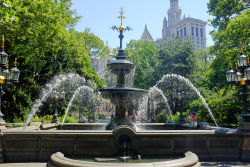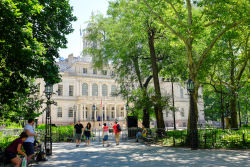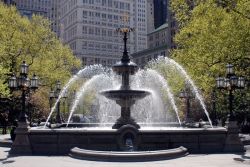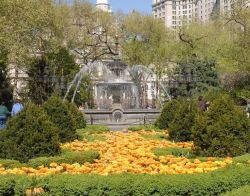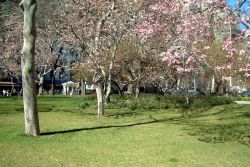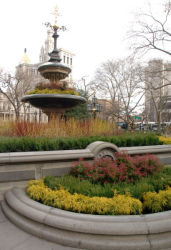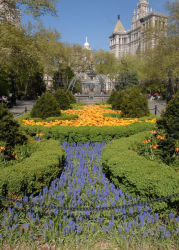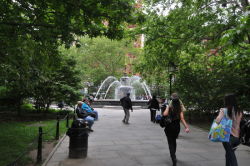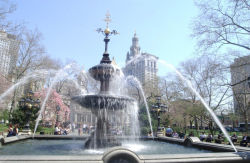City Hall Park
City Hall Park
City Hall Park, located in downtown Manhattan, has played a key role in New York civic life for centuries, from its Colonial beginnings as a rebel outpost to its current function as the seat of City government. The land has been used, among other things, as a pasture, a prison, a parade ground, a public execution site, an almshouse, an art museum, and a post office.
From 1653 to 1699 this area was known as the Commons and served as a communal pasture ground for livestock. The park’s western boundary was a Native American trail that later became Broadway. An almshouse for the City’s poor stood on this site from 1736 to 1797, at which point a second almshouse was built; archaeological evidence of the first structure was unearthed in 1989.
In 1757 construction began on a debtors’ prison and a soldiers’ barracks on the north end of the Commons where the Tweed Courthouse now stands. In 1765 New Yorkers protested the Stamp Act at the site, and a year later the first “Liberty Pole,” a commemorative mast topped by a vane featuring the word “liberty,” was built by pro-independence New Yorkers; a replica dating to 1921 now stands between City Hall and Broadway, near its original location. During the American Revolution (1776-1783) the British controlled New York and used the debtor’s prison to hold Revolutionary prisoners of war, executing 250 of them on gallows located behind the Soldiers’ Barracks.
In 1803 the cornerstone was laid for the current City Hall, which was designed by Joseph Mangin and John McComb. When the building opened in 1812 many felt that it was too far north of the center of the City. In 1818 a circular building called the Rotunda that housed the City’s first art museum was built on the park’s northeast corner, and in 1830 the debtors’ prison was converted to the City Hall of Records. In 1842 a fountain with a 100-foot-diameter basin and an impressive center jet capable of shooting water 50 feet into the air was built using water pumped in from the then-new Croton Aqueduct. New Yorkers continued to use the park for gatherings and events throughout the 19th century, including public meetings after the declaration of the Mexican-American War in 1846, and a call to volunteers in 1862 to enlist in the Civil War (1861-1865). During the Civil War the park was used to house troops in soldiers’ barracks. After President Lincoln was assassinated, his funeral procession for New York residents originated at City Hall.
Part of the southern tip of the park was sold to the Federal government in 1867 to build a post office. The Rotunda building was demolished in 1870 and in 1871 the Croton Fountain was replaced by a new fountain designed by Jacob Wrey Mould, co-designer of Central Park’s Bethesda Fountain, which became the centerpiece of the smaller park. Concerts were held at the park during the 1870s. In 1903 the park’s original gas streetlights were replaced by electric lamps. In 1939 the Post Office building was torn down, restoring the park to its original triangular shape, and reestablishing the open view of St. Paul’s Chapel from City Hall. In 1966 the City Hall building was designated a city landmark as well as a national landmark.
The park is home to more than a dozen monuments, including Frederick MacMonnies’s statue of Colonial patriot Nathan Hale (1893) and John Quincy Adams Ward’s Horace Greeley (1890), which was moved to the park in 1916. In 1920 the Mould fountain was dissembled and moved to Crotona Park in the Bronx to make way for MacMonnies’ controversial Civic Virtue (1922) fountain, which stood in the park from 1922 to 1941. Civic Virtue featured an allegorical figural group depicting a male figure stepping over two prone female figures, and as the object of much protest, was moved to Queens at Mayor Fiorello H. LaGuardia’s (1882-1947) request. The Delacorte Fountain (1972) stood at the site from 1972 until the park was renovated in 1999; it is now in the Bronx at Borough Hall Park. In 1991, during the construction of a nearby federal office building, an African burial ground was uncovered on portions of the northern part of the park, and designated as a City landmark and National Historic site in 1993.
In 1999 a $34.6 million project fully restored the park, adding a central walkway and gardens and replacing pavement with grass and trees. The Mould fountain with its original granite base was returned to the park with a reconstructed centerpiece and lighting fixtures. A circular tablet at the southern end of the park was added to educate visitors about the history of the site. At the park’s rededication, Mayor Rudolph W. Giuliani called the renovation “a final gift from the 20th century to New Yorkers of the 21st.”
Check out your park's Vital Signs
Clean & Safe
Green & Resilient
Empowered & Engaged Users
Share your feedback or learn more about how this park is part of a
Vital Park System

